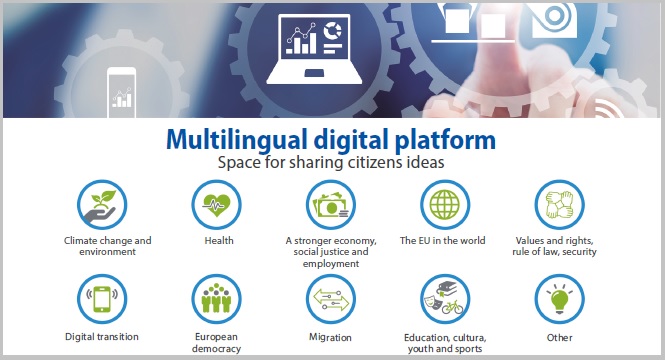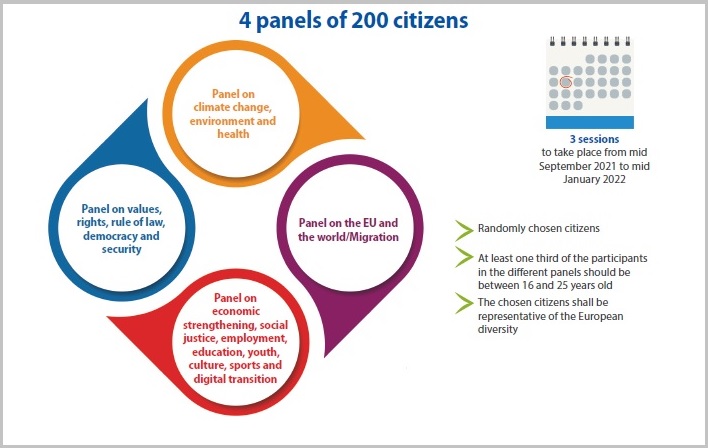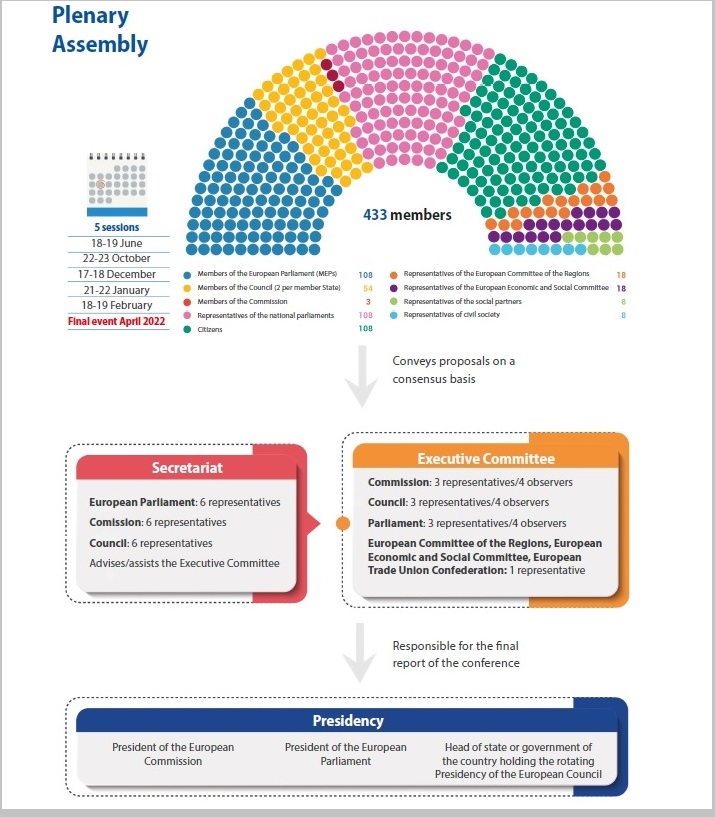The Conference on the Future of Europe, which formally began its work in May 2021, has to fulfil high and ambitious expectations as set by the EU’s highest-level officials: an unconditionally open practice of listening to the opinions of European citizens in all their diversity.
Background
Days before the last European elections in May 2019, French President Macron uttered what is now seen as the origin idea of the Conference on the Future of Europe, when hesaid that Europe was at ‘existential risk of rupture’ and proposed holding a ‘founding European convention after the elections’ involving leaders and citizens to ‘define Europe’s strategy for the next five years, including changes to the treaties’ that may be implemented.
In her inauguration speech at the European Parliament, Ursula von der Leyen, then still a candidate, also emphasised this key dimension of European citizenship within Europe’s common future and proposed the holding of the Conference on the Future of Europe, to be launched in 2020.
Finally, in her ‘Letter of Intent’ Dubravka Šuica, the Vice-President, responsible for democracy and demography, referred to the Conference in the following terms:
‘Europeans must have a say in how their Union is run and what it has to offer. That is why I believe we need a Conference on the Future of Europe, starting in 2020 and lasting two years. It should involve citizens of all ages in our Union, as well as civil society and the European institutions. We need a broad debate, clear objectives and a tangible follow-up of what is agreed’ (Šuica, 2019: 4).
Despite these general statements, the discussions around the launch of the Conference were particularly difficult, with disagreements concerning the Presidency of the Conference, its duration, its tasks, and the composition of its Plenary Assembly.
The dramatic outbreak of the pandemic altered the timetable of the Conference, but it also made the need for this debate on the future of Europe more all the more urgent.
The declarations and resolutions of the three institutions involved in this process shed light on the different assessments of the situation in which the Conference will take place, the different expectations regarding its outcome, and the limits regarding the demands that may be expressed through the different channels of citizen participation.
The European Parliament established a multi-stakeholder working group in October and adopted a resolution on the Conference in January 2020. In it the Parliament expresses the need for reform: ‘…that the number of major crises experienced by the European Union demonstrates the need for reform processes in multiple areas of governance’ (European Parliament, 2020: Recital B). And the Parliament proposed a bottom-up process that gives voice to European citizens (Recital E). The Parliament’s resolution proposes holding thematic agoras, random selections of citizens, and, specifically, two Youth Agoras. In general, the Parliament advocates: an inclusive and not predetermined process, so as to allow for more open participation by citizens; that the concrete recommendations resulting from the deliberative process be followed up; that these proposals may materialise in legislative initiatives even leading to the amendment of the Treaties; and it calls on the other two institutions to ‘make the same commitment’ (points 29/30 and 31).
For its part, the Commission published its communication on the Conference on 22 January 2020 (European Commission, 2020). The ambitions expressed in the declaration also refer to a new impetus for democracy in Europe and the need to listen to citizens. However, the Commission favours a more structured debate and, to this end indicates: ‘The conference should be framed around the EU’s main ambitions, as set out in the Commission’s six political priorities and the European Council’s strategic agenda’ (2020: 2). The Commission also proposes that the Conference address democracy and institutional issues, particularly the election of leading candidates for President of the Commission and transnational lists for the European Parliament. The Commission recommends using the experience accumulated in the different processes of structured dialogue with civil society. Finally,
‘The Commission is committed to taking the most effective measures, together with the other EU institutions, to ensure that the citizens’ debate feeds into the political process in the EU’ (2020: 4).
On 20 June 2020 the EU Council tabled its resolution, even though it had already signalled its commitment to the Conference at the December 2019 summit. The Council’s proposal envisaged a Conference offering an opportunity
‘...to underpin the democratic legitimacy and functioning of the European project, as well as to maintain EU citizens’ support for our common goals and values by giving them more opportunities to express themselves’ (EU Council, 2020: 2).
The Council advocates a Conference oriented towards specific policy first rather than a general proposal. To that end, the Council proposes that the content of the Conference should focus on a few key issues, including those of the Strategic Agenda whose breadth, according to the Council, is sufficient to address the most relevant issues, especially in the context of Covid-19 and the economic recovery process. The Council adds that in order to achieve the best results, the Conference should address overlapping issues related to improving the EU’s capacity to implement its policy priorities, such as: improved regulation, application of the principle of subsidiarity and proportionality, and implementation and enforcement of the acquis communautaire (body of common rights and obligations that are binding on all EU countries). In various paragraphs, the Council stresses its pragmatic orientation to the Conference, for example:
‘The organisation of the Conference should be based on some key principles: 1) equality between the institutions at all levels, 2) respect for the competences of each institution, 3) efficiency and avoidance of unnecessary bureaucracy and 4) effective participation of citizens’ (Council EU, 2020: 5). And the Council warned that the Conference will not fall within the scope of Article 48 TEU, which refers to the reform of the Treaties.
Finally, on 10 March 2021, the Joint Declaration on the Conference on the Future of Europe, establishing the framework of shared commitments, was signed by the presidents of the three institutions.
The Declaration echoes the need for a European policy at the level of citizens’ expectations and emphasises that ‘The Conference on the Future of Europe will open a new space for debate with citizens to address Europe’s challenges and priorities’ (EU, 2020: 1).
The commitment expressed by the Joint Declaration does not go beyond a commitment ‘…to listen to Europeans and to follow up on the recommendations expressed by the Conference’, but within the context of full respect for the competences of each institution and the principles of subsidiarity and proportionality expressed in the European Treaties. The scope of the Conference and its outcomes are formulated as ‘…a bottom-up, citizen-centered opinion exercise, enabling Europeans to express what they expect from the European Union’ (2020: 2). And a feedback mechanism will be ‘ensured’ so that the ideas expressed during the Conference events are translated into concrete recommendations for future EU action.
Regarding the outcome, a compromise formula has been sought which does not constrain the content of the final report that may be presented but does determine its scope:
‘The final outcome of the Conference will be presented in a report to the joint presidency. The three institutions will examine promptly how to follow up this report effectively, each within its own sphere of competence and in accordance with the Treaties.’
How is the Conference for the Future of Europe intended to work?
The governance structure
After several discussions concerning the establishing of the Presidency of the Conference, a joint presidency of the three institutions was agreed upon, involving the President of the European Parliament, the President of the European Commission and the head of state or government of the Member State holding the rotating presidency of the Council of the European Union (at the time of writing of this Policy Paper, Portugal).
The political direction of the work of the Conference is ensured by an Executive Committee, which decides by consensus on all matters relating to the organisation of the Conference, the preparation of the plenary sessions, and the drafting of the session reports.
The detailed composition of the Executive Committee consisting of the collegial presidency composed of the three institutions is:
- Parliament: Guy Verhofstadt, (Renew Europe, liberal); Commission: Dubravka Suica, (Vice-President of the Commission, responsible for democracy and demography); Council: Ana Paula Zacarias, (on behalf of the Portuguese Council Presidency).
The other members of the Executive Committee are:
- Parliament: Full members: Manfred Weber, (EPP, DE); Iratxe García (S&D, ES). Observers: Gerolf Annemans (ID, BE); Daniel Freund (Verts/ALE, DE); Zdizislaw Krasnodebski (ECR, PL) and Helmut Scholz (The Left, DE).
- Council: Gasper Dovzan, Slovenian Secretary of State for European Affairs and Clément Beaune, French Secretary of State for European Affairs.[1] There are also 4 observers on behalf of the Council who are the State Secretaries of the following countries in the rotating presidency after France: Czech Republic, Sweden, Spain, and Belgium.
- Commission: Maros Sefcovic, Vice-President, responsible for inter-institutional relations and Vera Jourová, Vice-President, responsible for values and transparency.
This Executive Commitee is assisted in its tasks by a joint secretariat composed on an equal basis by the three institutions with six representatives each.

Für die Bürger_innenbeteiligung entwickelt die Kommission eine mehrsprachige digitale Plattform. Diese Plattform ermöglicht vielfältige offene Interaktionen auf individueller wie kollektiver Ebene, die in den 24 Amtssprachen der EU stattfinden können. Sie wurde am 19. April 2021 offiziell in Betrieb genommen.
Mithilfe künstlicher Intelligenz werden auf der Plattform gesammelte Daten automatisch analysiert und daraus qualitative Berichte für die Bürgerforen und die Plenarversammlung erstellt.

Die europäischen Bürger*innenforen sind ein Eckpfeiler der Bürger*innenbeteiligung. Ziel dieser Foren ist es, auf der digitalen Plattform eingebrachte Vorschläge zu diskutieren und zusammenzufassen. Jedes dieser Foren setzt sich aus 200 Bürger_innen zusammen, von denen jeweils ein Drittel zwischen 16 und 25 Jahre alt sein muss. Die Teilnehmenden werden zufällig ausgefählt, um die Diversität der EU-Bevölkerung in Hinsicht auf geographische und sozioökonomische Herkunft, Alter, Bildungsstand und Geschlecht abzubilden.
Die Plenarversammlung der Konferenz ist der Ort für den Austausch. Sie wird ihre Arbeit entlang der Empfehlungen der europäischen und nationalen Bürgerforen und den Beiträgen auf der digitalen Plattform organisieren. Die 433 Sitze in der Plenarversammlung werden geschlechterparitätisch besetzt. 108 gehen an Europaabgeordnete, 54 an Ratsmitglieder (das sind 2 pro Mitgliedsstaat), 3 an Vertreter*innen der Kommission, 108 an Vertreter*innen der nationalen Parlamente (das sind 4 pro Mitgliedsstaat), weitere 108 an Bürger*innen (davon 80 aus den europäischen Bürger*innenforen, von denen mindestens ein Drittel zwischen 16 und 25 sein muss), 27 Sitze sind reserviert für Vertreter*innen der nationalen Bürger*innenforen (1 pro Mitgliedsstaat/nationales Forum), 18 für Vertreter*innen des Ausschusses der Regionen, weitere 18 für Vertreter*innen des Wirtschafts- und Sozialrates, 8 Sitze sind für Vertreter*innen der Sozialpartner*innen (Europäischer Gewerkschaftsbund und BusinessEurope) und die letzten 8 für Vertreter*innen der Zivilgesellschaft. Geht es thematisch um die Rolle der EU in der Welt, wird auch der/die Hohe Vertreter*in der Union für Außen- und Sicherheitspolitik eingeladen.
Für April 2022 ist eine Abschlussveranstaltung geplant, die also planmäßig in die französische Ratspräsidentschaft fällt. Sie wird Teilnehmende aus Plenarversammlung und Foren zusammenbringen. Das Plenum wird seine auf Konsensbasis entstandenen Vorschläge dem Exekutivausschuss übergeben. Dieser verfasst wiederum auf Grundlage der Schlussfolgerungen der Plenarversammlung und in Zusammenarbeit mit ihr den Abschlussbericht der Konferenz. Über den Bericht wird ebenfalls per Konsens abgestimmt. Danach wird er auf der digitalen Plattform veröffentlich und schlussendlich den drei Vorsitzenden der Konferenz übergeben. Die Prüfung der Vorschläge und das weitere Vorgehen obliegt dann den entsendenden Organisationen.
Anmerkungen
[1] Die den Rat vertretenden Länder tun dies turnusmäßig nach dem Rotationsprinzip des Ratsvorsitzes: Derzeit Portugal, danach Slowenien und Frankreich.
Quellen
Šuica, Dubravka (2019), Anhörung multimedia.europarl.europa.eu/en/hearing-of-dubravka-uica-vice-president-designate-democracy-and-demography-opening-statement-by-dubravka-uica_I178132-V_v
Europäische Kommission (2020), Konferenz zur Zukunft Europas https://ec.europa.eu/info/strategy/priorities-2019-2024/new-push-european-democracy/conference-future-europe_de
Europäisches Parlament (2020), Standpunkt des Europäischen Parlaments zur Konferenz über die Zukunft Europas https://www.europarl.europa.eu/doceo/document/TA-9-2020-0010_DE.pdf
Europäischer Rat (2020), Konferenz zur Zukunft Europas. https://data.consilium.europa.eu/doc/document/ST-9102-2020-INIT/en/pdf
Urspürunglich veröffentlich auf der Website des Institute 25M (Spanisch)
